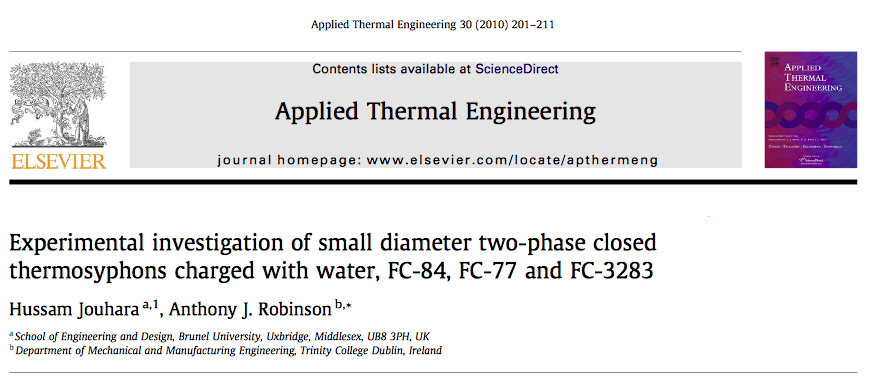Applied Thermal Engineering 30 (2010) 201–211
Experimental investigation of small diameter two-phase closed thermosyphons charged with water, FC-84, FC-77 and FC-3283
Hussam Jouhara, Anthony J. Robinson

Abstract
An experimental investigation of the performance of thermosyphons charged with water as well as the dielectric heat transfer liquids FC-84, FC-77 and FC-3283 has been carried out. The copper thermosyphon was 200 mm long with an inner diameter of 6 mm, which can be considered quite small compared with the vast majority of thermosyphons reported in the open literature. The evaporator length was 40 mm and the condenser length was 60 mm which corresponds with what might be expected in compact heat exchangers. With water as the working fluid two fluid loadings were investigated, that being 0.6 ml and 1.8 ml, corresponding to approximately half filled and overfilled evaporator section in order to ensure combined pool boiling and thin film evaporation/boiling and pool boiling only conditions, respectively. For the FluorinertTM liquids, only the higher fill volume was tested as the aim was to investigate pool boiling opposed to thin film evaporation. Generally, the water-charged thermosyphon evaporator and condenser heat transfer characteristics compared well with available predictive correlations and theories. The thermal performance of the water charged thermosyphon also outperformed the other three working fluids in both the effective thermal resistance as well as maximum heat transport capabilities. Even so, FC-84, the lowest saturation temperature fluid tested, shows marginal improvement in the heat transfer at low operating temperatures. All of the tested FluorinertTM liquids offer the advantage of being dielectric fluids, which may be better suited for sensitive electronics cooling applications and were all found to provide adequate thermal performance up to approximately 30–50 W after which liquid entrainment compromised their performance.
